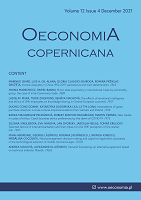Economic competitiveness vs. green competitiveness of agriculture in the European Union countries
Economic competitiveness vs. green competitiveness of agriculture in the European Union countries
Author(s): Anna Nowak, Armand KasztelanSubject(s): Business Economy / Management, Agriculture, Energy and Environmental Studies, Economic development, EU-Approach / EU-Accession / EU-Development
Published by: Instytut Badań Gospodarczych
Keywords: competitiveness; green competitiveness; agriculture; green growth; sustainable development; zero unitarization method;
Summary/Abstract: Research background: Many scientists have researched the economic competitiveness of agriculture. At the same time, considerably less attention is paid to the so-called green competitiveness. Considering a global trend searching for solutions to reduce the environmental impact of the agricultural sector, it seems reasonable to explore the overlap between economic competitiveness and green competitiveness. Purpose of the article: This study aims to answer the following questions: What is the level of economic and green competitiveness of agriculture in respective countries? What is the level of the comprehensive competitiveness of agriculture in EU member states? Do the economic competitiveness outcomes of respective countries coincide with their green competitiveness rankings? Methods: Taxonomic methods were applied to design synthetic indices of economic, green and comprehensive competitiveness of 27 member states of the European Union, based on multi-criteria sets of specific indicators from 2018. Findings & value added: The results of analyses imply that, in general, the level of green competitiveness of agriculture is higher than the level of its economic competitiveness in EU member states. Simultaneously, the developed rankings show that respective countries' economic and green competitiveness are not linked. In other words, economic competitiveness outcomes do not match green competitiveness outcomes for EU agriculture. This work is a genuine contribution to studies on the methods for measuring and evaluating the competitiveness of agriculture as it designs separate synthetic measures for economic and green competitiveness and confronts both types of competitiveness in EU member states. The research findings for the first time provide clear answers to questions about the mutual relationship between economic and green competitiveness in agriculture. Furthermore, an added value of this study is that it introduces and attempts to define the notion of green competitiveness.
Journal: Oeconomia Copernicana
- Issue Year: 13/2022
- Issue No: 2
- Page Range: 379-405
- Page Count: 27
- Language: English

